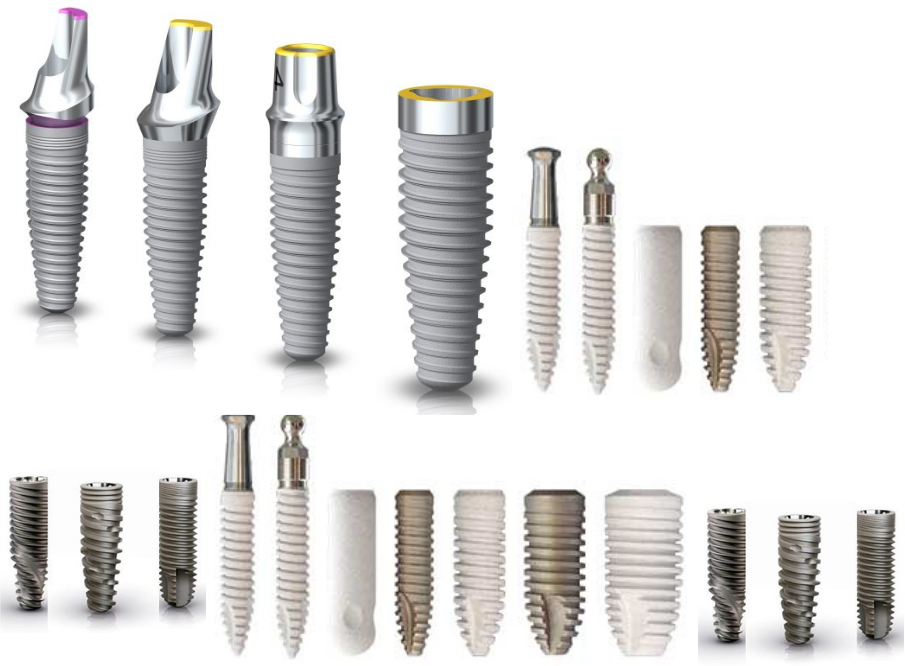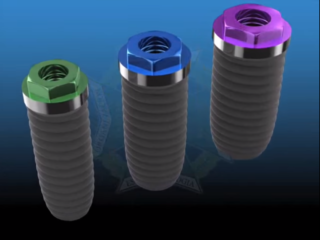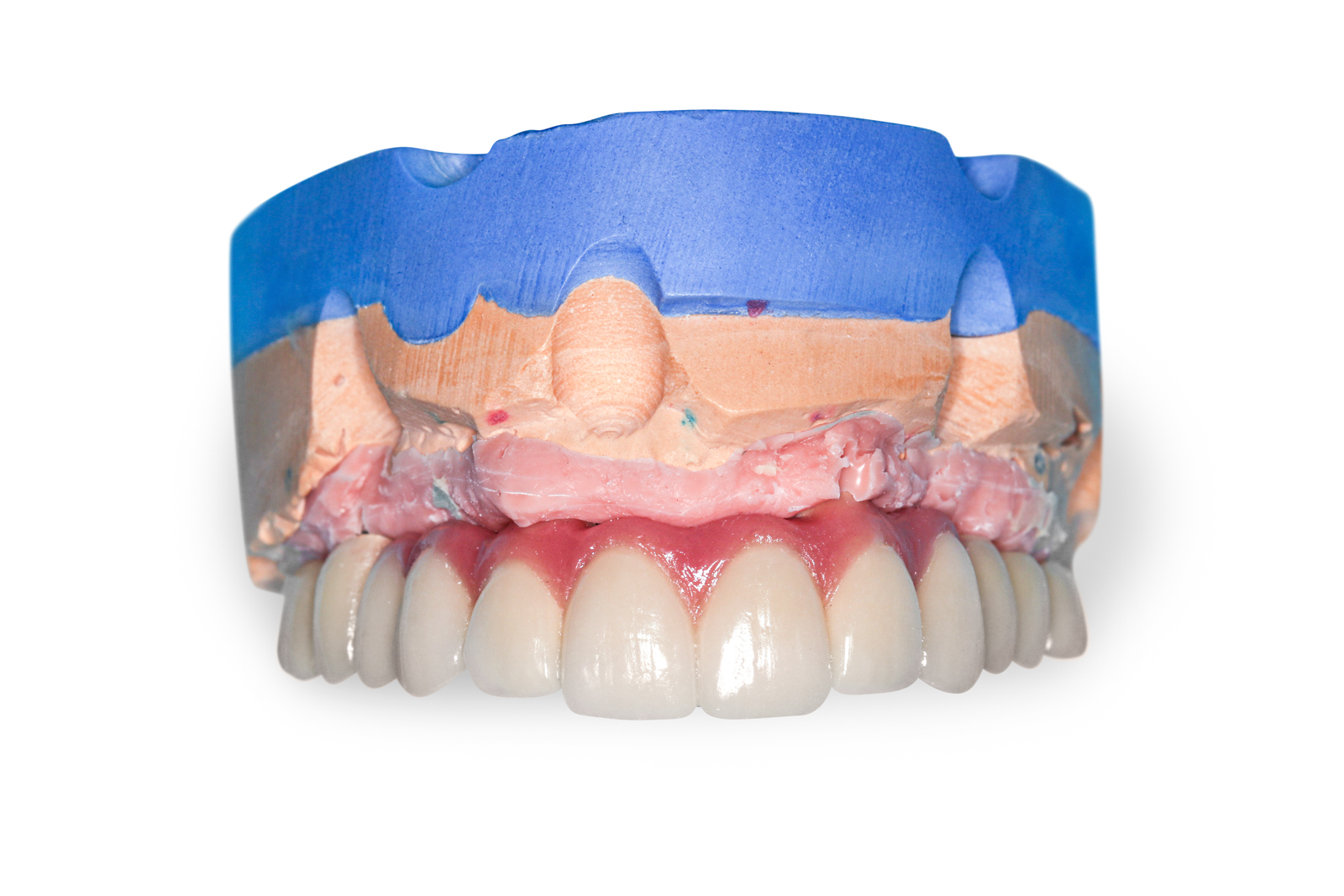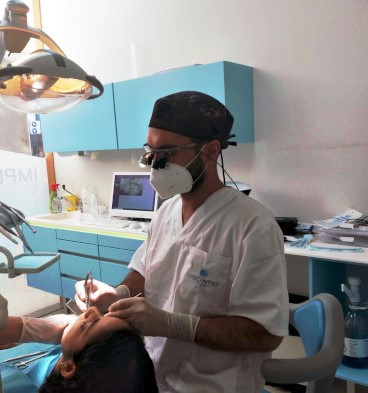What is a dental implant?

Dental implants are metallic structures with screw, conical, and thread shapes. Dental implants are made of a grey metal known as titanium. Their surface can be smooth, rough, or wrinkled, and is treated in different ways.
What are the characteristics of the dental implants?

Dental titanium implants
Most implants are made of pure titanium, however, this light metal is available in four categories.
This classification in categories depends on the carbon and iron levels present in their composition.
The surface of the implant is treated and modified through sandblasting, anodising (electrolytic bath), and plasma spraying. The aim is to increase osseointegration.
Why use dental implants?
The implant supports a crown or a crown set similar to natural teeth. It is the replacement for a missing or lost tooth root.
They act as anchors or supports to dental prostheses, crowns, or a set of crowns and dentures. Orthodontics use them as an anchor to move an orthodontic tooth; they help to correct misaligned teeth.
How is the procedure?
By using the bone formation surrounding the implant. There is a transference from the cells on the maxillary bone to the implant surface.
With bone regeneration, the implant is strongly anchored and prepared to receive the new tooth.
Can rejection occur?
The probability of rejection is between 1% to 6%. The implant may be loose and fall out, because there is no suitable bone formation. The rejection process does not cause any pain: the implant simply falls off or starts to get loose.
Rejection can occur in the first months, but is rare. This means that, for various reasons, the osteoblasts did not bind with the titanium surface.
About surgery
A surgery is performed to insert the implant on the maxillary or mandible bone. Usually, it is covered by the gum. The implant is not visible while osseointegration occurs. This procedure can be made with local anaesthesia in a dental office that is properly sterilised and equipped for this treatment.
Who can have dental implant surgery?
Everyone is a potential candidate for dental implants. However, the health professional will assess factors such as available bone, diseases such as diabetes, osteoporosis, hypertension, and the patient’s habits regarding smoking and alcohol.
Is the surgery painful?
You will not feel any pain and the discomfort is minimal. You may feel slight pressure and hear a little noise coming from the motor.
How long will they last?
In normal circumstances, an implant can last a lifetime. Contributing factors such as hygiene, regular visits to the dentist, and appropriate prosthesis use will help the implant’s lifespan.
About Dental Implants
Thanks to scientific advances, in some instances, it is possible to enter our clinic without any teeth and leave with a complete set of implanted, fixed teeth.
The dental implant will improve your appearance, self-esteem, confidence, and quality of life.
After treatment, our patients are able to chew and speak comfortably and today , they are much happier.
Dental Implants bridges

If you have several missing teeth, the dentist may recommend a dental bridge on the implants. The bridge reduces treatment cost and allows you to restore your natural appearance and speak properly.
Dentures supported by implants look like natural teeth. They enable you to eat whatever you like and help improve your quality of life. People who once felt embarrassed—due to dental issues, tooth decay, or missing teeth—are now amazed by the things they can do thanks to their new teeth.
As a result of our expertise and through the use of modern technology, the Vita Centre implants are not only affordable, but can also be easily fitted.
Planning of Dental Implant
1. Implant Surgery
This procedure is very simple and uses local anaesthesia. It is a painless procedure and takes about 15 minutes to place a single implant or an hour for All-On-4 Implants. For this type of implant surgery, you only need to stay one night in Portugal. Therefore, on the next day, you can go back to your home country.The recovery is simple and without complications.
2. Medication issued by the dentist
You should also apply ice wrapped in a cloth on the affected area. The patient should take the medication issued by the dentist, including an antibiotic and anti-inflammatory. There might be some minor swelling, which will gradually disappear.
You should return to the clinic a week later to have your stitches removed. In case you have to go back to your country, we will recommend a clinic in your home country to have your stitches removed.
3. Osseointegration
This process includes waiting from two to five months after implant placement to enable healing and regeneration.
During this period, bone cells will coat the small surface of the screw and develop on it until both, the bone and implant, transform into a single structure.
This structure will act as an anchor for the new artificial tooth. This process is called osseointegration.
4. Fixed prosthesis
Ceramic crowns or prostheses are screwed onto the implant. After this resting period, the patient will be asked to come back to our clinic to begin the production of a new artificial tooth. Therefore, moulds are created, aesthetics assessed and, subsequently, they will be sent to the laboratory. There might be some testing of the teeth to ensure the desirable result.
This procedure can take from 5 to 15 days. After this time, the procedure is completed and you will be able to chew and speak without restrictions or constraints.
Dental Implant Benefits
Quality of life
Essential functions, such as chewing, will be possible with the dental implants.
You can easily chew and savour your favourite foods without any embarrassment. It will also be possible to speak properly without the common problems caused by dentures.
Your aesthetic will improve because the face looks fuller and less sunken after treatment, creating a rejuvenated look.
There are so many other benefits and advantages to surprise the patient with all the new things he/she can do.
Implant Flexibility
The protocols regarding implantology are diverse and comprehensive. They restore teeth to patients who are toothless or simply fill the spaces if there are one or two teeth missing. It is possible to recreate an artificial gum to correct aesthetic flaws.
Sensitivity
By using dental implants, you will be able to better maintain sensitivity and taste the flavour of foods compared to removable prostheses, which have palates that make this more difficult.
Recent studies show that people’s bodies will start to develop compensation mechanisms and sensitivity around the titanium rod. Therefore, as time goes on, you will feel like they are your natural teeth.
Great dental hygiene
Hygiene is easy and effective. Treat them as you would natural teeth by brushing them regularly after eating. You can use mouthwash, dental floss, and a water pick to support the hygiene of individual and complete implants.
There is no damage to other teeth
Through the use of dental implants, you avoid eroding healthy teeth. This can happen when using a bridge over a tooth. Crowns over the teeth are an excellent alternative to improve aesthetics or fill in empty spaces. This abrasion can damage the tooth and increase its sensitivity. Therefore, by using implantology, the adjacent teeth remain intact, which is a great advantage.
Healthy bone
When inserted in the gum, the implants will help to preserve the alveolar bone. When you lose your teeth, the jaw bone structure has a tendency to atrophy. With the implants inserted on the bone, it will maintain its characteristics and avoid bone reabsorption and the resulting issues.
Improves body function
If you don’t have teeth, you cannot chew food properly. As a consequence, you could have gastrointestinal and digestive issues. Consequently the artificial teeth will help your body be healthier and function more efficiently.
Are there risks or contraindications
Possible complications are exclusively related to the some medication that a person may be taking. In the case of osteoporosis, some health professionals consider that certain drugs, such as bisphosphonates, may not be fully compatible with the treatment of osseo-integration. You should not worry about it, because the dentist will ask you the appropriate questions and decide the best way forward.
Experienced dentist

An experienced dentist will know how to deal with obstacles thanks to his/her expertise and a careful planning, assessment and review of the CT scans.
Dentists have an in-depth knowledge of the anatomy, surgical procedures and the implant system they use. Therefore the best prevention is a correct pre-treatment planning of each clinical case.
There is no risk as long as the protocol is performed by an experienced and qualified professional.
The rejection rate is minimal and rarely happens.
Success rates with dental implants
The success rate of a dental implants is very high and most people can keep them for many years and even a lifetime. The implants were discovered in the 1960s by Dr. Per-Ingvar Branemark, a Swedish doctor and research professor. He won numerous international awards and is well-known worldwide. A man carrying congenital malformations and with an edentulous mandible, named Gostan Larsson, was his first patient.
This patient kept the implants for about 40 years until 2006, when he passed away due to age. Since then, millions of titanium implants were placed all over the world. Tens of thousands of people got rid of the embarrassment of dentures and benefited from the technological development of modern implantology. Consequently the implants have made an important contribution to the quality of life of many, many people all around the world.
Conclusion about Dental Implants
Dental implant is the best treatment to replace missing teeth. One of the main advantages is how much they look like natural teeth. On the other hand, they allow you to eat all sorts of food without feeling embarrassed. In conclusion they are more resistant than dentures.
With implants, the bone loss caused by the missing teeth will no longer be an issue. Because of that there will be an aesthetic improvement.
Last updated on March 19, 2023
Scientific sources and studies:
Dental Implants
- Gunne J, Astrand P, Lindh T, et al. Tooth-implant and implant supported fixed partial dentures: a 10-year report. Int J Prosthodontics. 1999; 12:216-221.
- Grant BT,Pancko Fx,Kraut RA.Outcomes of placing dental implants in the posterior mandible.J.Oral Mxillofac Surg.2009.
- Romeo E,Ghisolfi M.Rozza R, et al.Dental implants in the rehabilitation of partial and complete edentulism.Int J Prosthodont 2006.
- Jemt L, Lekholm U.Implant treatment in edentulous maxillae.Int J Oral Maxillofac Implants.
- Dental implants in the rehabilitation of partial and complete edentulism. Int J Prosthodont 2006. Jemt L, Lekholm U. Implant treatment in edentulous maxillae. Int J Oral Maxillofac Implants.
- Branemark PL,et al -Clinical Procedures.Manual Branemark System,04-27,2000Zarb G,Bolender C, Carisson G. Boucher`s Prosthodontic treatment for edentulous patients.1997 11 th ed, Mosby-St.Louis.
- Toljanic JA, Baer RA, Ekstrand K,et al.Implant rehabilitation of the atrophic edentulous maxila including immediate fixed provisional restauration without the use of boné grafting.Int J Oral Maxillofac Implants.2009 May-Jun.
- Rosén A.Gynther G. Implant treatment .J.Oral Maxillofac Surg.2007
- Schropo L, Wenzel A, Kostopoulos L, et al. Bone healing and soft tissue contor changes following single-tooth extraction: a clinical and radiographic 12-month prospective study. Int J Periodontics Restorative Dent. 2003 Aug.
- Sakoh J. Wahlmann U, Stender E,at al. Primary stability of a conical implant and a hybrid, cylindric screw-type implant in vitro. Int J Oral Maxillofac Implants 2006.
Fixed prothesis
- Branemark PI, Svensson B, van Steenberghe E. Ten-years survival rates of fixed prostheses on four or six implants admodum . Branemark in full edentulism. Clin Oral Iplants Res 6: 227-231, 1995.
- Zarb GA, Bolender Cl, Hickey JC. Boucher`s prosthodontic treatment for edentulous patients, ed 10, ST Louis, 1990, Mosby
Zirconio
- Oliva J, Oliva X, Oliva JD. Zirconia implants and all-ceramic restorations for the esthetic replacement of the maxilary central incisors. Eur J Esthet Dent 2008; 3 : 174-185.
Hygiene of implants
- Matarasso S, Quaremba G, Coraggio F, et al. Maintenance of implants: an in vitro study of titanium implant surface modifications subsequent to the application of different prophylaxis procedures Clinical Oral Implants Research 2002. Volume 7 Issue 1: 64-72.
Bone Augmentation techniques
- Adell R, Lekholm U, Rockler B et al: Marginal tissue reaction at osseointegrated titanium fixtures, 3-year longitudinal prospective study. Int J Oral Maxillofac Implants 1986; 39-52.
- Adell R, Lekholm U, Rockler B, et al. A 15-year study of osseointegrated implants in the treatment of the edentulous jaw. International Journal of Oral Surgery 1981; 10: 387-416.
- Albrektsson T, Albrektsson B. Microcirculation in grafted bone. A chamber technique for vital microscopy of rabbit bone transplants. Acta Orthop Scand. 1978 Feb; 49: 1-7.
- Dahlin C, Andersson L, Linde A. Bone augmentation at fenestrated implants by an osteopromotive membrane technique. A controlled clinical study. Clin Oral Implants Res. 1991 Oct-Dec; 2:159-65.
- Friedlaender GE, Horowitz MC. Immune responses to osteochondral allografts: nature and significance. Orthopedics. 1992 Oct;15 (10): 1171-5.
- Traini T, Valentini P, lezzi G, Piattelli A. A histologic and histomorphometric evaluation of anorganic bovine bone retrieved 9 years after a sinus augmentation procedure. J Periodontol. 2007 May; 78 (5): 955-61.
Implants materials
- Bollen CM, Pappaioanno W, van Eldere J et al. The influence of abutment surface roughness on plaque accumulation and periimplant mucositis. Clin Oral Implants Res 1996;7:201-211.
- Petrie CS, Williams JL.Comparative evaluation of implant designs: influence of diameter, length and taper on strains in the alveolar crest.A three-dimensional finite- element analysis. Clin Oral Impl Res. 2005: (16): 486-494.
- Sakoh J, Wahimann U, Stender E, et al. Primary stability of a conical implant and a hybrid, cylindric screw-type implant in vitro. Int J Oral Maxillofac Implants. 2006; 21 (4): 560-566.

